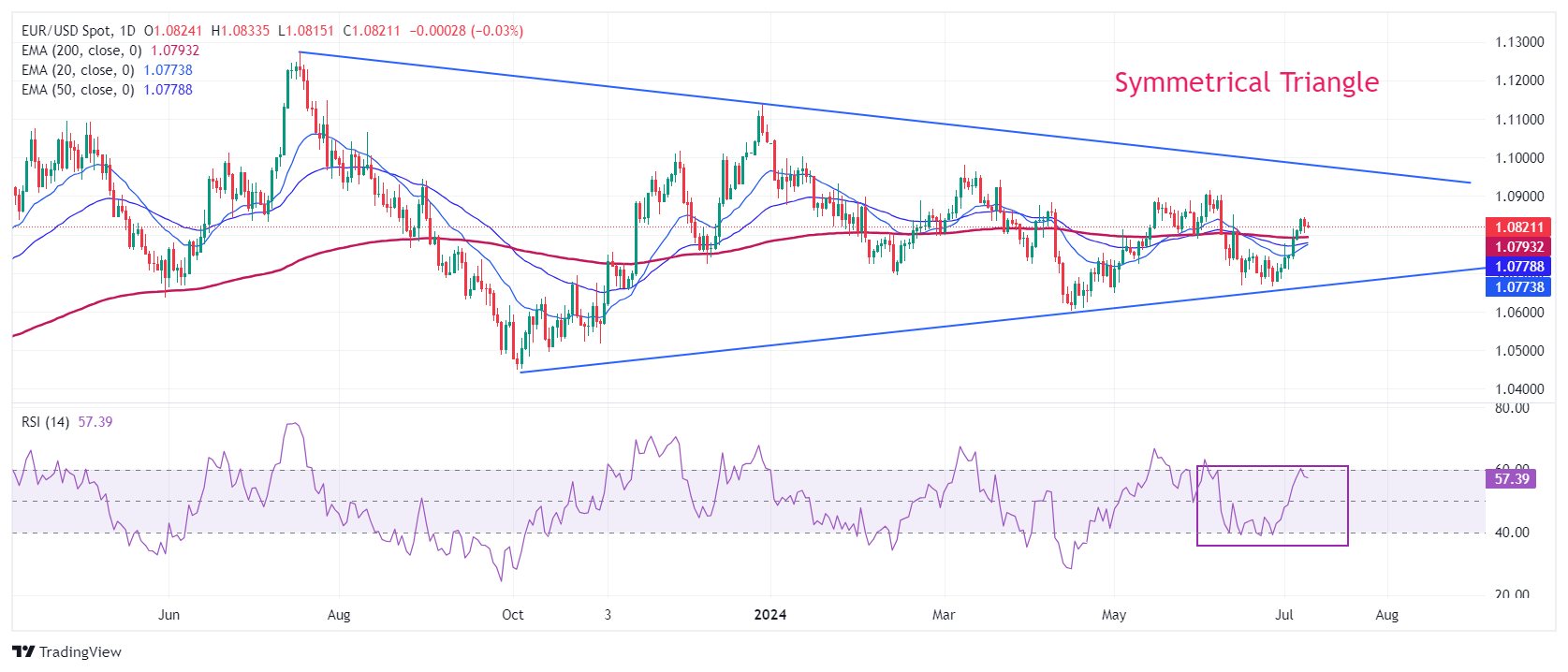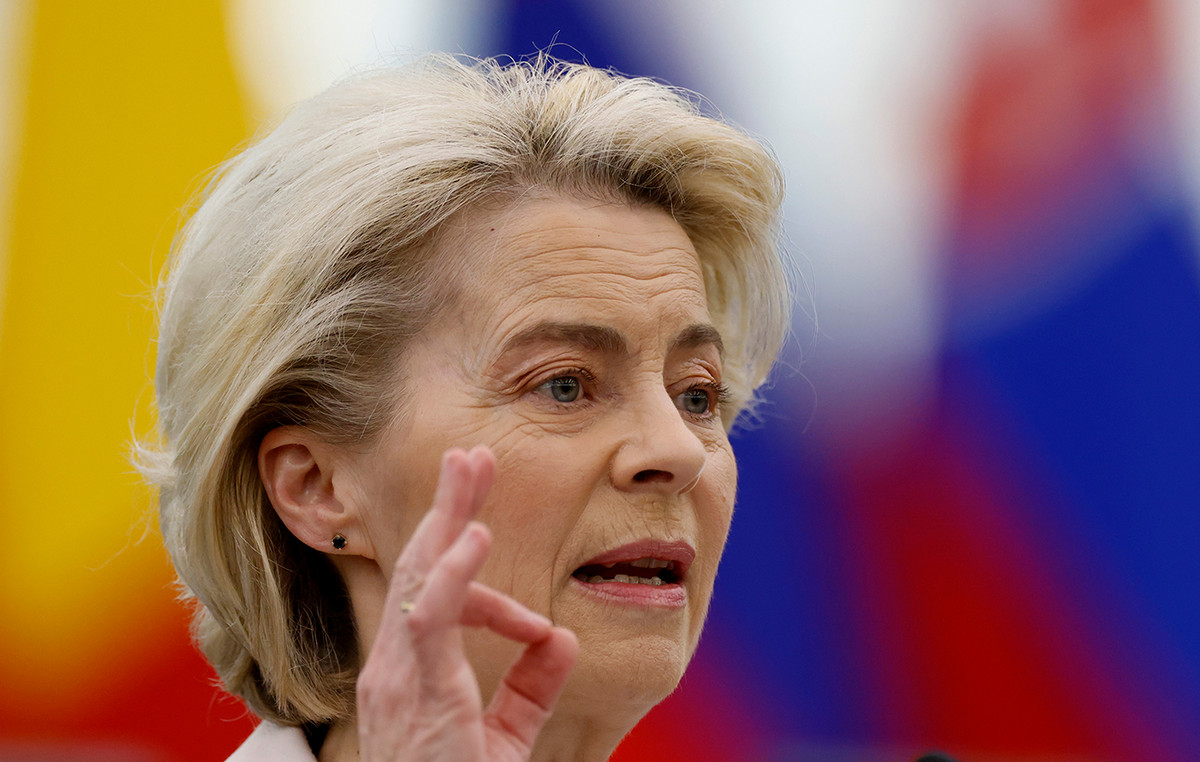- EUR/USD holds above 1.0800 as fading US labor market strength weighs on the US Dollar.
- Fed’s Powell may refrain from providing a specific time frame for rate cuts.
- ECB’s Knot does not see the central bank making any further rate cuts in July.
EUR/USD is holding on to gains above the crucial 1.0800 support in Tuesday’s European session. The major currency pair is holding onto gains as the US Dollar (USD) remains under pressure amid firm market speculation that the Federal Reserve (Fed) will start cutting interest rates in September.
According to the CME FedWatch tool, traders see a 77% chance that interest rates will be lower than current levels at the September meeting, up from 65.6% a week ago. Fading strength in the US labor market has boosted expectations that the Fed will shift to policy normalization in September. The unemployment rate rose to its highest level in more than two years, and average hourly earnings declined as expected in June, pointing to subdued labor market conditions.
For further guidance on interest rates, investors will focus their attention on Fed Chair Jerome Powell’s semi-annual testimony before Congress, scheduled for 14:00 GMT. Powell is expected to reiterate that interest rates should be kept steady at their current levels until inflationary pressures are seen to ease for months.
Powell acknowledged at the European Central Bank’s (ECB) Central Banking Forum that the central bank has made significant progress on inflation, and recent data show that the disinflation process has resumed.
For further clarity on disinflation, investors will focus on the US Consumer Price Index (CPI) report for June, due out on Thursday. The core CPI data, which excludes volatile food and energy prices, is estimated to have grown steadily, while the headline figures are expected to have slowed.
Daily Market Wrap: EUR/USD holds strength above 1.0800 as ECB Knot dismisses rate cut hopes
- EUR/USD is trading sideways above 1.0800 after marking a fresh three-week high near 1.0850 on Monday. The major currency pair is gaining strength as the outlook for the Euro improves after French election polls showed that Marine Le Pen-led far-right party, the National Rally, failed to win an outright majority. This has reduced the risks of a debt crisis in France.
- However, political uncertainty remains intact as no party wins an absolute majority. This leads to the formation of a coalition government resulting in a significant delay in fiscal decisions due to divergent opinions. Investors expect Jean-Luc Mélenchon’s left-wing coalition, which unexpectedly won more seats than the rest, to join President Emmanuel Macron’s centrist alliance to form a new government.
- Meanwhile, diminishing speculation that the ECB will make subsequent rate cuts at its July meeting has supported the euro’s decline. Officials expect price pressures to remain stable from their current levels this year, but an aggressive policy easing stance could revive them.
- On Monday, ECB policymaker and Dutch central bank chief Klaas Knot rejected expectations for rate cuts in July. Knot said in an interview with Handelsblatt, “I don’t see a case for another rate cut in July.” However, he was comfortable with market expectations for more rate cuts this year, and for that, he is open to the September meeting.
Technical Analysis: EUR/USD holds above 1.0800
EUR/USD is trading within Monday’s trading range as investors remain on the sidelines awaiting Fed’s Powell’s testimony. The major currency pair is stabilizing above the 20-day and 50-day exponential moving averages (EMAs), which are trading around 1.0750 and 1.0770, respectively. The overall trend of the shared currency pair has also strengthened as it has broken above the 200-day EMA, which is trading around 1.0800.
The Symmetrical Triangle formation on the daily time frame exhibits a strong contraction in volatility, indicating low volume and narrow ticks.
The 14-day Relative Strength Index (RSI) reaches 60.00. Will bullish momentum be triggered if it breaks above 60.00?
Euro FAQs
The Euro is the currency of the 20 European Union countries that belong to the Eurozone. It is the second most traded currency in the world, behind the US Dollar. In 2022, it accounted for 31% of all foreign exchange transactions, with an average daily volume of over $2.2 trillion per day. EUR/USD is the most traded currency pair in the world, accounting for an estimated 30% of all transactions, followed by EUR/JPY (4%), EUR/GBP (3%) and EUR/AUD (2%).
The European Central Bank (ECB), based in Frankfurt, Germany, is the reserve bank of the Eurozone. The ECB sets interest rates and manages monetary policy. The ECB’s main mandate is to maintain price stability, which means controlling inflation or stimulating growth. Its main instrument is to raise or lower interest rates. Relatively high interest rates – or the expectation of higher rates – generally benefit the Euro and vice versa. The Governing Council of the ECB takes monetary policy decisions at meetings held eight times a year. Decisions are taken by the heads of the national banks of the Eurozone and six permanent members, including ECB President Christine Lagarde.
Eurozone inflation data, as measured by the Harmonised Index of Consumer Prices (HICP), is an important econometric data point for the euro. If inflation rises more than expected, especially if it exceeds the ECB’s 2% target, the ECB is forced to raise interest rates to bring inflation back under control. Relatively high interest rates compared to their peers usually benefit the euro, as it makes the region more attractive as a place for global investors to park their money.
Data releases measure the health of the economy and can influence the Euro. Indicators such as GDP, manufacturing and services PMIs, employment and consumer sentiment surveys can influence the direction of the single currency. A strong economy is good for the Euro. Not only does it attract more foreign investment, but it can encourage the ECB to raise interest rates, which will directly strengthen the Euro. Conversely, if economic data is weak, the Euro is likely to fall. Economic data from the four largest Eurozone economies (Germany, France, Italy and Spain) are especially significant, as they account for 75% of the Eurozone economy.
Another important output for the euro is the trade balance. This indicator measures the difference between what a country earns from its exports and what it spends on imports during a given period. If a country produces highly sought-after export products, its currency will appreciate due to the additional demand created by foreign buyers who wish to purchase these goods. Therefore, a positive net trade balance strengthens a currency and vice versa for a negative balance.
Source: Fx Street
I am Joshua Winder, a senior-level journalist and editor at World Stock Market. I specialize in covering news related to the stock market and economic trends. With more than 8 years of experience in this field, I have become an expert in financial reporting.








